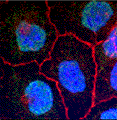Biochemistry, Department of
Document Type
Article
Date of this Version
2010
Citation
THE JOURNAL OF BIOLOGICAL CHEMISTRY VOL. 285, NO. 52, pp. 40515–40524, December 24, 2010
Abstract
Moorella thermoacetica is an anaerobic acetogen, a class of bacteria that is found in the soil, the animal gastrointestinal tract, and the rumen. This organism engages the Wood-Ljungdahl pathway of anaerobic CO2 fixation for heterotrophic or autotrophic growth. This paper describes a novel enzyme, oxalate oxidoreductase (OOR), that enables M. thermoacetica to grow on oxalate, which is produced in soil and is a common component of kidney stones. Exposure to oxalate leads to the induction of three proteins that are subunits of OOR, which oxidizes oxalate coupled to the production of two electrons and CO2 or bicarbonate. Like other members of the 2-oxoacid: ferredoxin oxidoreductase family, OOR contains thiamine pyrophosphate and three [Fe4S4] clusters. However, unlike previously characterized members of this family, OOR does not use coenzyme A as a substrate. Oxalate is oxidized with a kcat of 0.09 s-1and a Km of 58 µM at pH 8. OOR also oxidizes a few other 2-oxoacids (which do not induce OOR) also without any requirement for CoA. The enzyme transfers its reducing equivalents to a broad range of electron acceptors, including ferredoxin and the nickel-dependent carbon monoxide dehydrogenase. In conjunction with the well characterized Wood- Ljungdahl pathway, OOR should be sufficient for oxalate metabolism by M. thermoacetica, and it constitutes a novel pathway for oxalate metabolism.
Included in
Biochemistry Commons, Biotechnology Commons, Other Biochemistry, Biophysics, and Structural Biology Commons



Comments
© 2010 by The American Society for Biochemistry and Molecular Biology, Inc